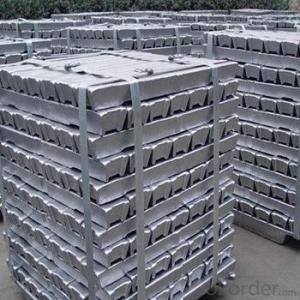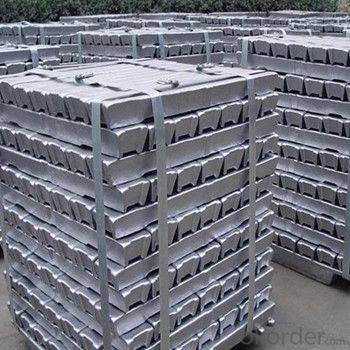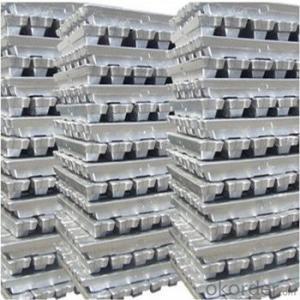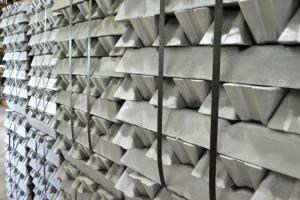Aluminum Ingot With Wholesale Price From Mills
- Loading Port:
- China main port
- Payment Terms:
- TT OR LC
- Min Order Qty:
- 100000 m.t.
- Supply Capability:
- 100000 m.t./month
OKorder Service Pledge
OKorder Financial Service
You Might Also Like
Pure Aluminum Ingot Used for Industry
1.Structure of Aluminum Ingot Description
A material that has been cast into a shape in order to be transported and processed easier than in an unprocessed form. An ingot is typically rectangular in shape, which allows it to be stacked. Ingots are most commonly associated with metals, with ingots of gold held in the vaults of banks and brokerages being popular images.
2.Main Features of the Aluminum Ingot
•High Purity
•High strength
•Fast melting
•Best price
•Good after-service
3. Aluminum Ingot Images


4. Aluminum Ingot Specification
Item | Aluminum Ingot 99.7,Aluminum bar/aluminum rod,Aluminum billet,Aluminum bar,6063 aluminium bar, Aluminium products | |
Standard | GB/T3191-1998,ASTM B221M-05A,JIS H4040-2006,etc | |
Material | 1A99,1A97,1A95,1A93,1A90,1A85,1A80,1A80A,1070,1070A,1370,A1060,1050,1050A,1A50, 1350,1145,1350,1A30,1160,1200,1235 2A01,2A02,2A04,2A06,2A10,2A11,2B11,2A12,2A13,2A14,2A16,2B16,2A17,2A20,2A21,2A25, 2A49,2A50,2A70,2A80 3A21,3003,3103,3004,3005,3105 4A03,4A11,4A13,4A17,4004,4032,4043,4043A,4047,4047A 5454,5154A,5754, 5056,5356,5456,5082,5182,5086 6A02,6B02,6A51,6101A,6005,6005A,6351,6060,6061,6063,6063A,6070,6181,6082 7A01,7A03,7A04,7A05,7A09,7A10,7A15,7A19,7A31,7A33,7A52,7003,7005,7020,7022,7050, 7075,7475 | |
| Size | Diameter | 1/2''-100'' |
Length | 1-12m,or as required. | |
Surface | Bright,polished,hair line,brush,embossed,etching,color coated,painted,etc | |
| Delivery time | 1.The products in stock will delivery immediately received the payment. 2.According to the order quantity,prompt delivery. | |
Export to | Ireland,Singapore,Indonesia,Ukraine,Spain,Canada,USA,Brazil,Thailand,Korea,Iran,India,Egypt, Kuwait,Oman,Viet Nam,South Africa,Dubai,Russia, England,Holland,etc | |
Package | Standard export package,such as wooden box or as required. | |
Application | Widely used in all walks of life,such as cars,ships,aerospace,aviation,electronics,agriculture, mechanical and electrical,home. | |
Container size | 20ft GP:5898mm(Length)x2352mm(Width)x2393mm(High) 24-26CBM 40ft GP:12032mm(Length)x2352mm(Width)x2393mm(High) 54CBM 40ft HC:12032mm(Length)x2352mm(Width)x2698mm(High) 68CBM | |
5.FAQ of Aluminum Ingot
We have organized several common questions for our clients,may help you sincerely:
①How about your company?
A world class manufacturer & supplier of castings forging in carbon steel and alloy steel,is one of the large-scale professional investment casting production bases in China,consisting of both casting foundry forging and machining factory. Annually more than 8000 tons Precision casting and forging parts are exported to markets in Europe,America and Japan. OEM casting and forging service available according to customer’s requirements.
②How to guarantee the quality of the products?
We have established the international advanced quality management system,every link from raw material to final product we have strict quality test;We resolutely put an end to unqualified products flowing into the market. At the same time, we will provide necessary follow-up service assurance.
③How long can we receive the product after purchase?
In the purchase of product within three working days, We will arrange the factory delivery as soon as possible. The pecific time of receiving is related to the state and position of customers.Commonly 7 to 10 working days can be served.
- Q: What is the impact of alloying elements on the properties of aluminum ingots?
- Alloying elements have a significant impact on the properties of aluminum ingots. By adding certain elements, such as copper, magnesium, or silicon, to aluminum, the resulting alloy can exhibit improved strength, hardness, corrosion resistance, and thermal conductivity. These alloying elements can also enhance the casting, machining, and welding characteristics of aluminum ingots, making them more versatile and suitable for a wide range of applications in industries like aerospace, automotive, and construction.
- Q: How much is a ton of aluminium ingots?
- Aluminum ingot one ton: 10 thousand and 2 - 10 thousand and 3 or so.
- Q: Now refining aluminum ingot profits? What are the main factories?
- The main fuel of the pot for coke, coal and coal, the effect is not good, the process is very simple, is to put the cans back into the pot melting aluminum water, with a spoon to scoop out the mold to cast into ingots, the need to pay attention to is because cans belongs to the thin material industry often said, it is easy to burn, the best the method is the first of the aluminum water in the pot, and then put the cans or pressed into blocks and then cast.
- Q: How do aluminum ingots contribute to the overall aluminum industry?
- Aluminum ingots play a crucial role in the overall aluminum industry as they serve as the primary raw material for the production of various aluminum products. These ingots are melted down and cast into different shapes, allowing manufacturers to create a wide range of aluminum-based products used in various industries, such as construction, automotive, aerospace, packaging, and electronics. Thus, aluminum ingots are vital for sustaining the growth and development of the aluminum industry by providing the necessary material for the manufacturing of diverse aluminum products.
- Q: What are the different surface coatings for aluminum ingots?
- Aluminum ingots can be treated with different surface coatings, each serving a specific purpose. The most commonly used coating is anodizing, which involves an electrochemical process that creates a protective oxide layer on the aluminum surface. Anodized aluminum offers improved durability, increased corrosion resistance, and can be dyed in various colors. Another option is powder coating, where a dry powder is applied to the aluminum surface and then cured under heat to form a hard, protective layer. This type of coating provides excellent resistance to abrasion, impact, and chemicals, and it can be applied in a wide range of colors and finishes. For applications requiring enhanced lubricity or low friction, a Teflon or PTFE (polytetrafluoroethylene) coating can be utilized. This coating reduces friction and wear, improves release properties, and offers excellent chemical resistance. In certain cases, aluminum ingots may also undergo galvanization, which involves coating them with a thin layer of zinc. This zinc coating provides protection against corrosion and can be further enhanced by applying a powder coating or paint on top. Additionally, various organic coatings such as acrylic, epoxy, or polyurethane can be applied to aluminum ingots to achieve a decorative finish or protect against environmental factors like UV radiation or moisture. Ultimately, the choice of surface coating for aluminum ingots depends on specific application requirements, such as the need for corrosion resistance, durability, friction reduction, or aesthetic appeal.
- Q: What are the different surface treatments for aluminum ingots?
- Some common surface treatments for aluminum ingots include anodizing, powder coating, painting, and polishing. Anodizing involves creating a protective oxide layer on the surface of the ingot, while powder coating and painting provide a decorative and protective coating. Polishing is done to enhance the appearance and smoothness of the aluminum surface.
- Q: What are the energy requirements for producing aluminum ingots?
- The energy requirements for producing aluminum ingots are significant, as the production process involves several stages that consume large amounts of electricity. The primary energy-intensive steps include mining and refining bauxite ore into alumina, which requires a substantial amount of electrical power. Additionally, the electrolytic reduction of alumina to aluminum in the smelting process demands a significant energy input. Overall, the production of aluminum ingots is an energy-intensive process that necessitates substantial electricity consumption.
- Q: What are the advantages of using aluminum ingots in the production of packaging materials?
- There are several advantages of using aluminum ingots in the production of packaging materials. Firstly, aluminum is lightweight yet sturdy, making it an ideal choice for packaging materials as it ensures easy handling and transportation while providing protection to the contents inside. Secondly, aluminum is a highly malleable metal, allowing for flexibility in design and customization of packaging shapes and sizes according to specific requirements. Additionally, aluminum is corrosion-resistant, ensuring the durability and longevity of packaging materials, even in harsh environments. Furthermore, aluminum has excellent barrier properties, effectively protecting the packaged goods from moisture, oxygen, and other external factors that could potentially degrade the product quality. Lastly, aluminum is a sustainable material, as it is easily recyclable without losing its properties, contributing to the circular economy and reducing the environmental impact of packaging waste.
- Q: What are the limitations of using aluminum ingots in high-temperature applications?
- Using aluminum ingots in high-temperature applications comes with several limitations. Firstly, aluminum's melting point is relatively low, around 660 degrees Celsius. This means it may not be able to withstand the extremely high temperatures commonly found in industrial processes or aerospace applications. When exposed to such elevated temperatures, aluminum tends to soften and lose its mechanical strength, compromising the integrity and functionality of the component or structure. Secondly, aluminum has a high coefficient of thermal expansion, causing it to expand significantly when exposed to heat. This expansion can result in dimensional instability and issues like warping or distortion, especially during rapid or uneven heating and cooling cycles. These changes in dimensions can affect the accuracy of the final product, necessitating additional measures to compensate for the thermal expansion. Additionally, aluminum has relatively poor resistance to oxidation at high temperatures. When exposed to oxygen at elevated temperatures, aluminum can form a thin layer of aluminum oxide, which acts as a protective barrier against further oxidation. However, at extremely high temperatures, this layer can break down, making aluminum more susceptible to oxidation and corrosion. This can lead to a decrease in the strength and durability of the aluminum component. Lastly, aluminum has lower strength compared to materials like steel or titanium. Although aluminum alloys can be developed to enhance their strength, they may still not be suitable for applications requiring exceptional strength at high temperatures. In situations where high mechanical strength is crucial, alternative materials with superior high-temperature strength properties may be more suitable. In conclusion, the limitations of using aluminum ingots in high-temperature applications include their low melting point, high coefficient of thermal expansion, susceptibility to oxidation, and relatively low strength. These factors must be carefully considered when selecting materials for high-temperature applications to ensure the desired performance and reliability of the components or structures.
- Q: Can aluminum ingots be recycled?
- Indeed, aluminum ingots possess the ability to undergo recycling. Being a remarkably recyclable substance, aluminum undergoes a process of melting down the ingots, subsequently reusing the metal to fabricate fresh commodities. The act of recycling aluminum ingots not only aids in preserving natural resources but also results in substantial energy savings when juxtaposed with the production of aluminum from raw materials. Moreover, the recycling of aluminum plays a pivotal role in waste reduction and mitigating the environmental consequences linked to mining and extraction procedures.
Send your message to us
Aluminum Ingot With Wholesale Price From Mills
- Loading Port:
- China main port
- Payment Terms:
- TT OR LC
- Min Order Qty:
- 100000 m.t.
- Supply Capability:
- 100000 m.t./month
OKorder Service Pledge
OKorder Financial Service
Similar products
Hot products
Hot Searches




























